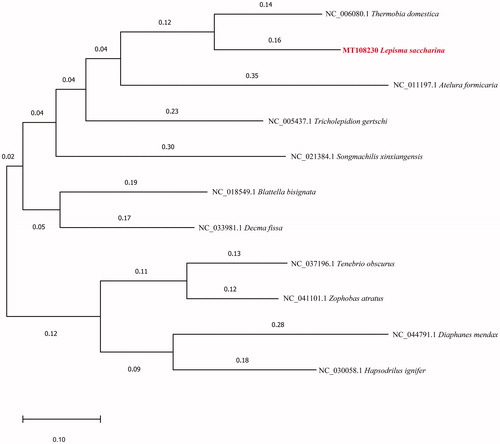Abstract
The common silverfish, Lepisma saccharina, is a well-known stored-product insect worldwide, which were obtained from China. The complete mitochondrial genome (GenBank: MT108230) consists of a circular DNA molecule of 15,244 bp with A/T bias of 66.46% AT content, which is longer by 92 bp than the complete mitogenome of Thermobia domestica (GenBank: AY639935.1). It comprises 13 protein-coding, 22 tRNA, and 2 rDNA genes. The protein-coding genes have typical ATN (Met) initiation codons except for cox1 for TTG and nad5 for GTG, and are terminated by typical TAN stop codons.
The common silverfish, Lepisma saccharina, is a stored-product insect and feeds on a variety of materials, such as paper and cereals worldwide (Wang et al. Citation2006). Here, we first reported the characterization and phylogenetic studies of the complete mitochondrial genome (mitogenome) of L. saccharina to better comprehend its molecular evolution and taxonomic classification.
Samples of adult L. saccharina were obtained from Jingziguan Town (E111.026°, N33.244°), Xichuan County, Nanyang City, Henan Province, China, on 28 October 2019 and deposited by Yu Bai in the animal specimen room of Guiyang University with Specimen Accession Number: GYU-20191028-001. We obtained approximately 13,491.70 Mbp of raw data using an Illumina NovaSeq 6000, 13,377.63 Mbp of which were high-quality, clean data (99.15%). The mitogenome was assembled de novo with Velvet 1.2.10 (Zerbino and Birney Citation2008), gaps of which were filled with SSPACE 3.0 (Boetzer et al. Citation2011) and GapFiller 1.1 (Boetzer and Pirovano Citation2012).
The mitogenome of L. saccharina (GenBank: MT108230) consists of a 15,244 bp circular DNA molecule with 37.67% A, 28.79% T, 22.19% C, and 11.35% G, which is an A/T bias of 66.46% AT-content, which is longer by 92 bp than the complete mitogenome of Thermobia domestica (GenBank: AY639935.1) (Cook et al. Citation2005). The AT- and GC-skews of the major strands of the mitogenome were calculated to be approximately 0.1336 and 0.3233, respectively. The A/T-rich region in the mitogenome is 399 bp, with a 76.94% A + T content, and is located between the srRNA and tRNA-Ile.
The mitogenome of L. saccharina contains 13 protein-coding genes (PCGs), 22 tRNA genes, and 2 rRNA genes. The order and orientation of the L. saccharina mitogenome functional areas are identical to those of Tenebrio obscurus, Zophobas atratus, and Blaps rynchopetera mitogenome functional areas (Bai et al. Citation2018, Citation2019; Yang et al. Citation2019). All 13 PCGs have typical ATN (Met) start codons, except cox1 for TTG and nad5 for GTG: two genes (nad6 and atp6) – ATA; two genes (atp8 and nad3) – ATT; seven genes (nad2, cox2, cox3, nad4, cob, nad1, and nad4l) – ATG. All 13 PCGs had typical TAN stop codons: four genes (nad3, cox3, nad4, and nad4l) – TAA; three genes (nad2, cob, and nad1) have a TAG stop codon; six genes (cox1, cox2, atp8, atp6, nad5, and nad6) – an incomplete stop codon consisting of a T that is completed by the addition of 3′-A nucleotides to the resultant mRNA. The 22 tRNA genes are interspersed throughout the coding region and range from 63 (tRNA-Arg) to 74 bp (tRNA-Met). The lrRNA and srRNA genes are 1308 and 789 bp long, respectively.
To validate the phylogenetic position of L. saccharina, the mitogenome DNA sequences from 11 species of Insecta were used to construct a phylogenetic tree by the maximum likelihood method using the MEGA-X 10.1.7 (Kumar et al. Citation2016) (). Lepisma saccharina was closely clustered with T. domestica. Overall, our study provides insight into the mitogenome of L. saccharina, which will be useful for its taxonomic classification and further phylogenetic reconstruction.
Disclosure statement
No potential conflict of interest was reported by the author(s).
Additional information
Funding
References
- Bai Y, Li C, Yang M, Liang S. 2018. Complete mitochondrial genome of the dark mealworm Tenebrio obscurus Fabricius (Insecta: Coleoptera: Tenebrionidae). Mitochondrial DNA Part B. 3(1):171–172.
- Bai Y, Wang H, Li G, Luo J, Liang S, Li C. 2019. Complete mitochondrial genome of the super mealworm Zophobas atratus (Fab.) (Insecta: Coleoptera: Tenebrionidae). Mitochondrial DNA Part B. 4(1):1300–1301.
- Boetzer M, Henkel CV, Jansen HJ, Butler D, Pirovano W. 2011. Scaffolding pre-assembled contigs using SSPACE. Bioinformatics. 27(4):578–579.
- Boetzer M, Pirovano W. 2012. Toward almost closed genomes with GapFiller. Genome Biol. 13(6):R56.
- Cook CE, Yue Q, Akam M. 2005. Mitochondrial genomes suggest that hexapods and crustaceans are mutually paraphyletic. Proc R Soc B. 272(1569):1295–1304.
- Kumar S, Stecher G, Tamura K. 2016. MEGA7: molecular evolutionary genetics analysis version 7.0 for bigger datasets. Mol Biol Evol. 33(7):1870–1874.
- Wang S-Y, Lai W-C, Chu F-H, Lin C-T, Shen S-Y, Chang S-T. 2006. Essential oil from the leaves of Cryptomeria japonica acts as a silverfish (Lepisma saccharina) repellent and insecticide. J Wood Sci. 52(6):522–526.
- Yang Y, Bai Y, Zheng J, Chen J, Ouyang B, Liang S. 2019. Characterization of the complete mitochondrial genome of Blaps rynchopetera Fairmaire (Insecta: Coleoptera: Tenebrionidae) from Dali. Mitochondrial DNA Part B. 4(2):3167–3168.
- Zerbino DR, Birney E. 2008. Velvet: algorithms for de novo short read assembly using de Bruijn graphs. Genome Res. 18(5):821–829.

